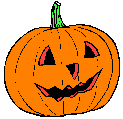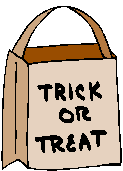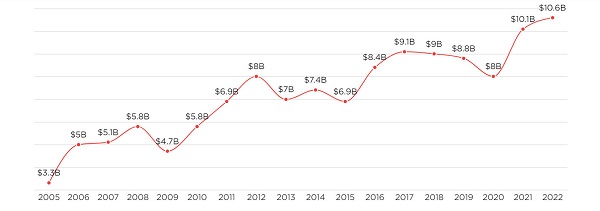

2025 Halloween Facts, Trends and Statistics: Spending, Costume Choices and More
The observance of Halloween, which dates back to Celtic rituals thousands of years ago (see this page for the history of Halloween), has long been associated with images of witches, ghosts, devils and hobgoblins. In the United States, the first official citywide Halloween celebration occurred in Anoka, Minn., in 1921. Over the years, Halloween customs and rituals have changed dramatically. Today, many of the young and young at heart take a more light-spirited approach. They don scary disguises or ones that may bring on smiles when they go door to door for treats, or attend or host a Halloween party. And the tradition has spread to other countries: Japan and France have ever-growing Halloween parties and activities.
half the population participates in Halloween
About 180 million people in the US celebrated Halloween in 2019, 2020 , with the COVID Grinchcanceling trick or treating saw it drop. 2022 was a big rebound year, easily 190 million, above the 180 million Americans took part in Halloween festivities in 2018 and 179 million in 2017, up from 171 million Americans celebrated Halloween in 2016 and 157 million Americans celebrated Halloween in 2015. The top costume for children is usually an action hero or superhero, and the top choice for adult women is a witch. Pets are also dressed up as 10 percent of consumers put their dog or cat in a pumpkin costume.
2023 will probably continue the rebound. At least with regard to trick or treating. How will the extremely high gas, food and other prices from the inflation of the past 2 years affect it, is difficult to say.
Spending on Halloween in 2025 is likely to be up slightly from 2023 ($12.2 billion) and 2019 (which was $8.8 billion) but up from the covid years, 2020 ($8 billion), 2022 ($10.6B) and 2021 ~$10.1 billion)
2024 early estimate: $13 billion
It's really hard to tell this year because inflation has been so persistently high since 2020 that many will cut back, while the higher prices may make the overall spend flat.
Negatives
- Candy, costume, gas, food prices are WAY up!
- Income is flat for most families.
- Consumer sentiment is anxious, many perceive the economy is in trouble
- Crime in many areas has skyrocketed - will people feel safe taking their children trick or treating?
Positives
- Consumers are most likely still rebounding from Covid and wanting to return to normal
Conclusion
Each consumer is likely to cut back on the quantity of purchases, But since inflation has been so extremely high for two years, the overall spend should remain about the same. Consumers will simply get less for their money.
Generational Trends
A Harris poll cited in this CNBC story says that
- Younger people (Millennia's) are expected to spend $183 each on candy, costumes, decorations and miscellaneous items.
- Generation X'ers are expected to spend about $70 each and
- Baby boomers only $23 each
In 2018, according to Lendedu.com
- The average American spent $185.50 on Halloween in 2018. This figure is up from 2017's: $169.81
- Within that total expenditure,
$76.05 (41%) will go towards candy,
$66.78 (36%) will go towards costumes, and
$42.67 (23%) will go towards decorations
The National Retail Federation (NRF) puts the figure lower, saying Individuals are planning to spend an average of $86.79, up from 2017’s $86.13.
I can't say which figure is more valid; perhaps, Lendedu uses a per household figure and NRF is per adult consumer? Intuitively, that could make sense, because I've never spent $185 on Halloween ever...but, if I add up my kid's costumes, decorations and candy, $185 could be plausible.
In 2017, according to the National Retail Federation (NRF)
- 71% of those surveyed by the National Retail Federation handed out candy,
- 49% decorated
- 48% wore a costume
- 46% carved a pumpkin,
- 35% threw or attended a party
- 23% visited a haunted house, and
- 16% dress up their pets (most often as a pumpkin).(ref)

All of these percentages are up substantially from previous years. There was a dip during the covid lockdowns but it has rebounded since.The spend is an average $82.93, up from 2015's $74.34 on decorations, candy, costumes and more. And the numbers really add up: according to the NRF survey, Americans are expected to spend $2.6 billion just on Halloween costumes for adults, children and pets. Total spending in 2016 - including candy and decorations - is expected to reach $8.4 billion according to the history of NRF's annual survey. Contrast that with 2010 when consumers spent $66.28 per person—which for a total of approximately $5.8 billion—on Halloween costumes, cards, and candy. And that was up from $56.31 in 2009. To see this data in graphs, click here!
View spending survey results here.
Below are some interesting numbers and statistics regarding Halloween in the United States. You may also want to see this page for similar information about pumpkin production in the U.S.
The trend in spending by US consumers on Halloween follows the economy
in general, but overall is always upwards. Here's the NRF's graph (I think
2016 will end up being UP even more- come back next year to see if I'm right):.
"Trick or Treat!"
36.1 million - The estimated number of potential trick-or-treaters in 2006 (the most current year for which data is available) children 5 to 13 — across the United States, down 45,000 from 2005. Of course, many other children — older than 13, and younger than 5 — also go trick-or-treating.
109.6 million - Number of occupied housing units across the nation in 2006 (the most current year for which data is available) all potential stops for trick-or-treaters.
93% - Percentage of households who consider their neighborhood safe. In addition, 78 percent said they were not afraid to walk alone at night. (Source: Extended Measures of Well-Being: Living Conditions in the United States, 2003, at
Jack-O'-Lanterns and Pumpkin Pies
1 billion pounds - Total production of major
pumpkin-producing states in 2006. Illinois led the country by
producing 492 million pounds of the vined orange gourd. Pumpkin patches
in California, Ohio and Pennsylvania also provided lots of pumpkins:
Each state produced at least 100 million pounds. The value of all
pumpkins produced by major pumpkin-producing states was $101 million.

Where to Spend Halloween?
Some places around the country that may put you in the Halloween mood are:
- Transylvania County, N.C. (29,780 residents).
- Tombstone, Ariz. (population 1,571).
- Pumpkin Center, N.C. (population 2,228); and Pumpkin Bend, Ark. (population 307).
- Cape Fear in New Hanover County, N.C.; and Cape Fear in Chatham County, N.C. (the townships have populations of 15,711 and 1,170, respectively).
- Skull Creek, Neb. (population 281).
Candy and Costumes
In 2016, the top selling costumes for children are action/superhero, princess, animal, Batman character and a Star Wars character.
The top five costumes for adults are a Batman character, a witch,
and animal, a superhero, and a vampire.
Also popular are, for
boys, Zombies, Minions, Star Wars and for girls Disney's Frozen
characters, especially Princess Elena.
Top costumes last year, according to the National Retail Federation:
Top 10 Children's Costumes
- Recent Years
|
|||||||||||||||||||||||||||||||||||||||||||||||||||||||||||||||||||||||||||||||||||||||||||
| Top 10 Adult Costumes - This Year and Previous Years | ||||
| 2019 data | 2017 rank | 2015 rank | ||
| 2019 Rank | Adults | Adults | Adults | |
| 1 | Witch | 1 | 8 |
Click here for this item on Amazon |
| 2 | Vampire | 7 | 1 |
Click here for this item on Amazon Click here for this item on Amazon |
| 3 | Character from Batman | 2 | 3 |
Click here for this item on Amazon |
| 4 | Pirate | 4 | 8 |
Click here for this item on Amazon Click here for this item on Amazon |
| 5 | Avengers character (excluding Spider-Man) |
Click here for this item on Amazon | ||
| 6 | DC superhero (excluding Batman, Wonderwoman, and Star Wars) | 8 | NR |
Click here for this item on Amazon |
| 7 | Star Wars character | NR | - |
Click here for this item on Amazon |
| 8 | Ghost |
Click here for this item on Amazon Click here for this item on Amazon | ||
| 9 | Superhero (any of them) | 6 | 5 |
Click here for this item on Amazon |
| 10 | Clown |
Click here for this item on Amazon | ||
| NR | Villain from a Slasher Movie | 9 | NR | |
| NR | Animal (Dog, Cat, etc) | 3 | 2 | |
| NR | Wonder Woman | 10 | NR | |
| Top 10 Pet Costumes - This Year and Previous Years | |||
| 2019 Rank | Pets | 2017 Rank | |
| 1 | Pumpkin | 1 | |
| 2 | Hot dog | 2 | |
| 3 | Bumblebee | 4 | |
| 4 | Devil | 5 | |
| 5 | Cat | 8 | |
| 6 | Dog | 7 (tie) | |
| 7 | Lion | 7 (tie) | |
| 8 | Star Wars character | 10 | |
| 9 | Superhero | 9 | |
| 10 | Ghost | 7 | |
| NR | Witch | 9 | |
2015's top costumes were very similar.
For comparison, here's the list from 2013:
| Top Adult Costumes |
Top Children's Costumes |
Top Pet Costumes |
| 1. Witch |
1. Princess |
1. Pumpkin |
| 2. Batman character |
2. Animal |
2. Hot dog |
| 3. Vampire |
3. Batman character |
3. (T) Cat |
| 4. Zombie |
4. Action/super hero |
3. (T) Devil |
| 5. Pirate |
5. Spider-Man |
4. Witch |
| 6. Action/super hero |
6. Witch |
5. Superman |
| 7. Superman |
7. Zombie |
6. Dog |
| 8. Dracula |
8. Disney princess |
7. Bowties/fancy collar |
| 9. Cat |
9. Superman |
8. Bee |
| 10. Scary costume/mask |
10. Fairy |
9. (T) Batman |
| |
|
9. (T) Vampire |
| |
|
10. Ghost |
- 1,198 -
Number of U.S. manufacturing
establishments that produced chocolate and cocoa products in 2005,
employing 38,718 people and shipping $13.6 billion worth of goods.
California led the nation in the number of chocolate and cocoa
manufacturing establishments, with 128, followed by Pennsylvania, with
121.
(2005 Value of Product
Shipments)

- 477 - Number of U.S. establishments that manufactured non-chocolate confectionary products in 2005. These establishments employed 21,389 people and shipped $7.6 billion worth of goods that year. California also led the nation in this category, with 73 establishments. (2005 Value of Product Shipments)
- 26 pounds -
Per capita consumption of candy by
Americans in 2006; it is believed a large portion is consumed around
Halloween.
- 2,232
- Number of costume rental and formal wear establishments across the nation in 2005.
Sources and references
- NRF (National Retail Federation
- CNBC
- Halloween.” National Confectioners Association. Accessed: September 30, 2010.
- Rogers, Nicholas (2002). "Samhain and the Celtic Origins of Halloween". Halloween: From Pagan Ritual to Party Night, pp.11-21. New York: Oxford University Press. ISBN 0-19-516896-8
- Roger, Nichola (2002). Halloween: From Pagan Ritual to Party Night. Oxford University Press. pp. 28-30. ISBN 0-19-514691-3.
- Arnold, Bettina (2001-10-31). "Bettina Arnold - Halloween Lecture: Halloween Customs in the Celtic World" . Halloween Inaugural Celebration. University of Wisconsin-Milwaukee: Center for Celtic Studies. http://www.uwm.edu/~barnold/lectures/holloween.html . Retrieved 2007-10-16.
- Skal, David J. (2002). Death Makes a Holiday: A Cultural History of Halloween, p.34. New York: Bloomsbury. ISBN 1-58234-230-X.
- Pope John Paul, July 1994, conversation with the author in Rome, Italy
- US Census Bureau
Other fun and useful Halloween information
- Halloween around the world
- How to choose a pumpkin
- How to EASILY carve a beautiful Jack-O-Lantern, fully illustrated!
- How to make a pumpkin pie from an actual pumpkin (it's easy!)
- Other pumpkin recipes (pie, soup, bread, roasted seeds)
- History of the Jack-o-Lantern
- Tips for a safe and fun Halloween
- Halloween clip art
- Pumpkin Facts and What to do with the pumpkin after Halloween.
- Halloween links to Halloween web sites
Halloween Costumes
Here are some of the most popular Halloween costumes for children this year. For more choices, see our Halloween costumes pages.
- Inflatable Riding Dinosaur Costume for Adults - everyone LOVES this costume. It's a hit where ever you go!
- Harry Potter Costume Kids Plush Robe - With a hood, one for each house, Gryffindor, Hufflepuff, Slytherin, Ravenclaw, Hogwarts
- Wizard Robe Cloak Halloween costume for Kids
- Girl's Sparkle Princess Costume - In pink, for small girls
- Sew your own Halloween Costumes with Patterns from the Singer Sewing Reference Library
- Pizza Costume for Kids - A giant slice of pizza Halloween Costume for Children and Teens
- Easy Halloween Costumes for Children - Miniature patterns for 3 to 12 year old children, just enlarge and use
Find Related Information and Resources Here!
Here's the quick list to related farms for PYO, Honey, Pumpkins, Christmas trees, etc.:
You may find these websites useful!
- Local pick your own farms for apples, strawberries, raspberries, corn, tomatoes, etcr
- Farm markets and roadside stands
- Local Honey Finder
- Children's consignment sales
- Local Meat, Milk and Eggs
- Christmas Tree Farms and lots
- Road tripping and camping tips, tricks and How-to's
- Fun Factory Tours
- Venues for you event: Farms, Wineries, Orchards for your event, wedding or party
- Easter egg hunts
- Festivals: Fruit and vegetable festivals
- Winery tours and wine tastings
- Horses: rides, stables, lessons, trails
- Maple Syrup farms and sugarworks
- Bed and Breakfasts on Farms, Wineries, Ranches and Orchards
- Zombie Paintball venues
- Environmental resources
- Consumer fraud information
- Wholesale food sources
- Resources for Farmers
- Pumpkin patches
- Corn mazes
Water bath canning kit - 8 Piece Enamelware Pot with Canning kit and Rack. Canning Supplies Starter Kit
Double Donut Pumpkin Spice Coffee Pods, Single Serve Flavored Coffee for Keurig K Cups Machines,
Pumpkin Spice - Organic, 1.94-Ounce Jar, Nutmeg, Cloves, Ginger & Cinnamon, Enhances Tea, Seasoning, Kosher
Maud's Pumpkin Spice Instant Latte - 16 count Packets, Love Me Some Pumpkin Spice Latte
Pumpkin Pie Spice Blend Extract,McCormick Pure
Don't miss our page of costumes, ready made and ones you can make yourself!
And here's a book of 130 pumpkin carving stencils!
Pumpkin Carving stencils book - Over 130 Halloween jack olantern pumpkin designs. Including Witches, Cats, skulls, bats, ghosts, and so much more
More carving kits and stencils are here!
Find Other types of farms:
- Pick Your Own apples
- Christmas Tree Farms and lots
- Farm markets and roadside stands
- Local Honey
- Local Meat, Milk and Eggs
- Road trip and camping
Get the
most recent version of
the Ball Blue Book
Click here to get Halloween Costumes delivered - fast, great prices!
Click here to get Halloween Costumes delivered - fast, great prices!
Find Other types of farms:
- Pick Your Own apples
- Christmas Tree Farms and lots
- Farm markets and roadside stands
- Local Honey
- Local Meat, Milk and Eggs
- Road trip and camping
Get the
most recent version of
the Ball Blue Book